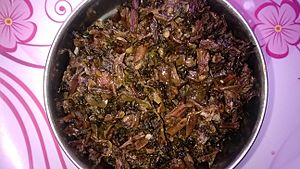Gundruk facts for kids

Gundruk left out in the sun for drying process
|
|
| Place of origin | Nepal |
|---|---|
| Region or state | Nepal; Sikkim, Darjeeling and Kalimpong regions of India |
| Main ingredients | leafy green vegetables of radish, cauliflower, roots of radish |
Gundruk (Nepali: गुन्द्रुक) is a special kind of fermented leafy green vegetable. It comes from Nepal. Fermentation is a process where tiny living things (like bacteria) change food, often making it last longer or taste different.
Besides Nepal, gundruk is also very popular with Gorkhali and Nepalese families living in other countries. You can find it in India, Bhutan, Myanmar, and many other places around the world. About 2,000 tons of gundruk are made in Nepal each year. Most of it is made by families at home.
Gundruk is made from leafy vegetables called saag (Nepali: साग). People usually eat it as a side dish with their main meal. It can also be a tasty appetizer. Gundruk is a good source of minerals. This is especially important when fresh vegetables are not easy to find. During those times, people might eat a lot of starchy foods like tubers and maize, which don't have many minerals.
Contents
Making Gundruk: From Farm to Food
Choosing and Preparing Leaves
In October and November, farmers harvest their first broad mustard, mustard greens, radish, and cauliflower leaves. They often have more leaves than they can eat fresh.
These extra leaves are left out for a day or two to wilt a little. Then, they are cut into small pieces using a knife or a sickle.
Adding Radish Roots for Flavor
Not just the leaves, but also the roots of the radish can be used to make gundruk. Using radish roots can make the gundruk taste even better. The roots are mixed with the leaves and crushed together. It's important not to make the pieces too small when crushing them.
In the mountains of central Nepal, the crushed radish and leaves are put into a clay pot. They are pressed down tightly. Then, the opening of the pot is closed very well.
Fermenting and Drying Gundruk
The pot is often buried in a safe, sunny spot. Sometimes, it's just placed in an open area. After a few days, you can taste or smell if it has become acidic enough. This means the fermentation is working!
Once it's ready, the gundruk is taken out and dried in the sunlight. Gundruk made this way is usually very tasty, full of flavor, and nicely acidic.
How Gundruk Ferments
The Fermentation Process
The cut-up leaves are packed very tightly into a clay pot. Warm water (around 30°C or 86°F) is added to cover all the leaves. The pot is then kept in a warm place.
After about a week, the gundruk will have a mild acidic taste. This shows that the fermentation is finished. Then, the gundruk is taken out and dried in the sun. This process is similar to how sauerkraut or kimchi are made. However, no salt is added to the leaves before gundruk fermentation begins.
Tiny Helpers: Microorganisms
The temperature during fermentation is usually around 18°C (64°F). Tiny living things called Pediococcus and Lactobacillus are the main microorganisms that work during gundruk fermentation. These are types of bacteria that are good for food.
During fermentation, the pH of the gundruk slowly drops to about 4.0. The amount of acid (like lactic acid) increases to about 1% by the sixth day.
Scientists have found that the traditional way of making gundruk can cause a loss of 90% of the carotenoids. Carotenoids are important nutrients, and they are probably lost during sun-drying. Better ways of drying might help keep more of these vitamins.
See also
 In Spanish: Gundruk para niños
In Spanish: Gundruk para niños


